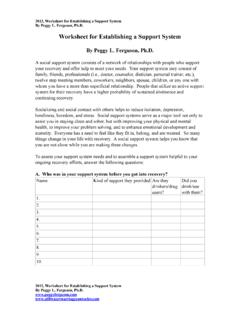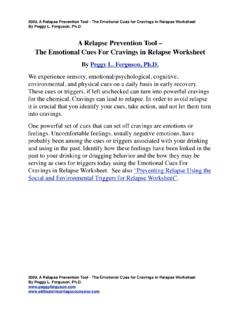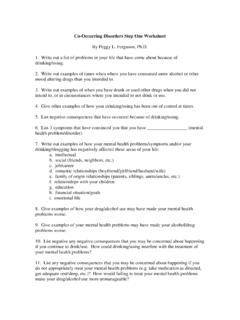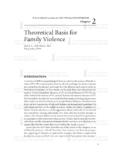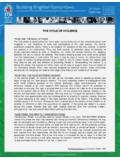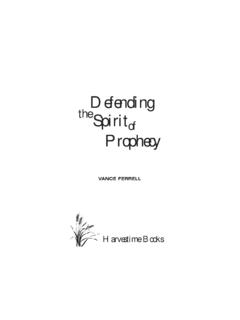Transcription of Survival Roles Develop Within The Family of Alcoholics and ...
1 Survival Roles Develop Within The Family of Alcoholics and Addicts By Peggy L. Ferguson, A very common lecture provided by treatment centers about the impact of addiction on the Family is one called The Family Trap . This standard in Family addiction treatment comes from the pamphlet, The Family Trap: No one escapes from a chemically dependent Family by Sharon Wegscheider-Cruse, where she outlined Family systems concepts and identified stereotypic Roles that Develop Within the Family dynamics of addiction. This information is still as helpful today as it was when it came out. Some key concepts and descriptions of the Survival Roles are presented here. Important concepts involve the Family as a system. A system is a collection of parts that together create an entity that is more than the total of its parts. A system seeks to maintain equilibrium (even if it is unhealthy) and to maintain itself.
2 The presence of addiction in a Family system tends to create or perpetuate pathology Within that system. Each part of a system affects every other part and is affected by every other part. The addict s relationship to the chemical contributes to the Family pathology. The addicted person is also affected by the Family pathology and by every other member of the Family . Addiction is a disease that affects the entire Family . Addiction brings about pain in the addict and in Family members. As the addict becomes more and more disabled by addiction, Family members adapt to accommodate the changes in the addict. Family dynamics of interaction become stereotyped over time and practice. Family members Develop Survival Roles that allow them to experience the least amount of personal pain and stress. These Survival Roles include, the victim (the addict), the chief enabler , the Family hero , the lost child , the scapegoat , and the mascot.
3 In the midst of the active addiction, before recovery, Family members are not generally aware that they are playing out these identifiable, commonplace Survival Roles . The Survival Roles serve the functions of reducing emotional pain or stress Within the individuals occupying the Roles and Within the Family itself. As the addiction continues to progress Within the addict, the addiction takes its toll on relationships, on work and career, on spirituality, on emotional and mental health, and on physical health. Addiction has the same deleterious effects on the Family . Family members repress their feelings with Survival Roles that defend them against the pain. Defenses permit Family members to live in delusion just as the denial allows the addict to avoid dealing with the reality of the addiction. The whole Family loses touch with reality. As the addiction and the maladaptive Family dynamics progress over time, Family members become more and more compulsive in their stereotypic behavior with the addict.
4 Survival Roles allow the Family members to experience less pain by creating a wall of defenses. The chief enabler can be the spouse, an adult child enabling the parent, or a parent enabling a child, adolescent or adult child. The chief enabler is usually the person closest to the addict. There is often a mutual dependence between the addict and the chief enabler. As the addiction continues to progress over time, the chief enabler feels more and more compelled to try to compensate for the loss of control by trying to take control of the situation. The chief enabler s job is to provide responsibility for the Family . They run around like a chicken with the head cut off making the mortgage payments, getting the kids off to school, taking care of household chores, paying the bills, and sending birthday cards to both sides of the Family . In essence, they are doing it all or feel like they are.
5 The wall of defenses that hide the fear, anger, hurt, guilt, and pain of the chief enabler includes powerlessness, seriousness, self-blaming, super-responsibility, manipulation, self-pity, and fragility. The Family hero is often the oldest child. This child often knows more about what is going on in the Family than anyone else. They attempt to reduce the Family pain by trying to improve the situation. They are often the school athlete, the class president, the cheerleader, or mother s little helper . They often hold part time jobs, and sometimes serve as a surrogate spouse. Their job is to provide self-worth to the Family system. Because of the progressive nature of the disease, the Family hero is always losing ground. The feel responsible for the Family , try to enact adult Roles , and usually feel inadequate. The wall of defenses that hides the pain of loneliness, hurt, inadequacy, confusion, and anger, are success, being overly responsible, feeling special , developing an independent life away from the Family , approval seeking through hard work, having an appearance of competence and confidence.
6 The scapegoat is often identified as the problem in the Family . This is the child who is usually in trouble at home and at school. As untreated adults, they continue to get into trouble at work and socially. This child s role in the Family is to provide focus for the anger and tension in the Family . The Family can focus on the behavior of this child and maintain their denial of the other problems (addiction). Instead of seeking approval from the Family by hard work like the Family hero, this child seeks approval from a peer group instead. Their job is to provide focus and distraction to the system. The wall of defenses that hides the pain of loneliness, anger, fear, hurt, and rejection, are withdrawing from the Family to the peer system, unplanned pregnancy, drinking/using, acting out, and angry, defiant, sullen behavior. The lost child is often the middle child.
7 This child also tends to withdraw as Survival . Instead of withdrawing to a peer group, this child withdraws into himself/herself. They may engage in a lot of fantasy. They tend to keep to themselves and stay out of the way. They are not acting out and they are not overachieving to win approval. So, they don t get much attention in the Family . This child would be daydreaming in class, probably has few friends, and typically fits in invisibly. The child s job is to provide relief because no one has to worry about him/her. The wall of defenses that hides the pain of loneliness, hurt, inadequacy, and anger are the quiet, aloof, withdrawn, super independent, distancing/rejecting behavior. The mascot is often the youngest sibling. They are cute, funny, and charming. No one takes them too seriously. They may be the class clown in school. Their job is to provide fun and humor.
8 This child usually knows least what is going on in the Family and they feel fear. The wall of defenses that hides the feelings of fear, insecurity, confusion, and loneliness are the hyperactive, funny, cute, clowning around behavior that gains them attention that they crave. Sometimes they appear fragile underneath the distraction. The alcoholic/addict feels guilt, shame, hurt and fear, but hides it from himself/herself by the defenses of anger, charm, rigidity, perfectionism, grandiosity, self-righteousness, and aggression. Each Family member can be characterized by specific repetitive behavior. These Survival behaviors are personally costly. Each person pays a high price to use these Survival Roles . They can persist beyond the addicted system into new families of choice as the children grow up and marry. They can persist into a work context, where children of Alcoholics find themselves enacting childhood Roles .
9 Survival Roles can be passed down to subsequent generations, through modeling and learning. Family members may play one role in a Family context and other Roles in different Family contexts. A common example is the Family hero who marries an addict and takes on the role of the chief enabler. Sources: Wegsheider-Cruse, Sharon. 1976. The Family Trap, Johnson Institute. Wegsheider-Cruse, Sharon, 1989. Another Chance-Hope and Help for the Alcoholic Family , Science and Behavior Books. Copyright 2011, Peggy L. Ferguson, , Hubbard House Publishing, Stillwater, Oklahoma.

